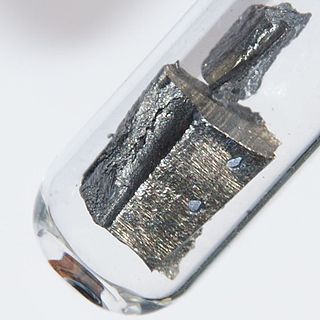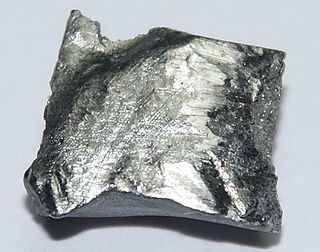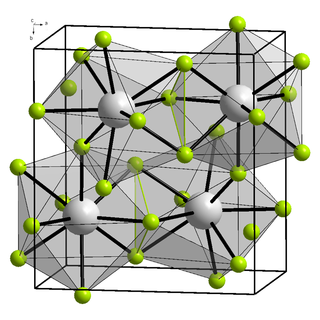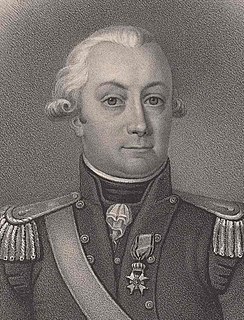Related Research Articles

Holmium is a chemical element with the symbol Ho and atomic number 67. Part of the lanthanide series, holmium is a rare-earth element.

Neodymium is a chemical element with the symbol Nd and atomic number 60. Neodymium belongs to the lanthanide series and is a rare-earth element. It is a hard, slightly malleable silvery metal that quickly tarnishes in air and moisture. When oxidized, neodymium reacts quickly to produce pink, purple/blue and yellow compounds in the +2, +3 and +4 oxidation states. Neodymium was discovered in 1885 by the Austrian chemist Carl Auer von Welsbach. It is present in significant quantities in the ore minerals monazite and bastnäsite. Neodymium is not found naturally in metallic form or unmixed with other lanthanides, and it is usually refined for general use. Although neodymium is classed as a rare-earth element, it is fairly common, no rarer than cobalt, nickel, or copper, and is widely distributed in the Earth's crust. Most of the world's commercial neodymium is mined in China.

Terbium is a chemical element with the symbol Tb and atomic number 65. It is a silvery-white, rare earth metal that is malleable, ductile, and soft enough to be cut with a knife. The ninth member of the lanthanide series, terbium is a fairly electropositive metal that reacts with water, evolving hydrogen gas. Terbium is never found in nature as a free element, but it is contained in many minerals, including cerite, gadolinite, monazite, xenotime, and euxenite.

Ytterby is a village on the Swedish island of Resarö, in Vaxholm Municipality in the Stockholm archipelago. Today the residential area is dominated by suburban homes.

The rare-earth elements, also called the rare-earth metals or rare-earth oxides, or the lanthanides are a set of 17 nearly indistinguishable lustrous silvery-white soft heavy metals. Scandium and yttrium are considered rare-earth elements because they tend to occur in the same ore deposits as the lanthanides and exhibit similar chemical properties, but have different electronic and magnetic properties.
The periodic table is laid out in rows to illustrate recurring (periodic) trends in the chemical behaviour of the elements as their atomic number increases: a new row is begun when chemical behaviour begins to repeat, meaning that elements with similar behaviour fall into the same vertical columns. The fifth period contains 18 elements, beginning with rubidium and ending with xenon. As a rule, period 5 elements fill their 5s shells first, then their 4d, and 5p shells, in that order; however, there are exceptions, such as rhodium.

Gadolinite, sometimes known as ytterbite, is a silicate mineral consisting principally of the silicates of cerium, lanthanum, neodymium, yttrium, beryllium, and iron with the formula (Ce,La,Nd,Y)
2FeBe
2Si
2O
10. It is called gadolinite-(Ce) or gadolinite-(Y), depending on the prominent composing element. It may contain 35.5% yttria sub-group rare earths, 2.2% ceria earths, as much as to 11.6% BeO, and traces of thorium. It is found in Sweden, Norway, and the US.

Group 3 is the first group of transition metals in the periodic table. This group is closely related to the rare earth elements. Although some controversy exists regarding the composition and placement of this group, it is generally agreed among those who study the matter that this group contains the four elements scandium (Sc), yttrium (Y), lutetium (Lu), and lawrencium (Lr). The group is also called the scandium group or scandium family after its lightest member.

Epidote is a calcium aluminium iron sorosilicate mineral.

Cleveite is an impure radioactive variety of uraninite containing uranium, found in Norway. It has the composition UO2 with about 10% of the uranium substituted by rare-earth elements. It was named after Swedish chemist Per Teodor Cleve.

Xenotime is a rare-earth phosphate mineral, the major component of which is yttrium orthophosphate (YPO4). It forms a solid solution series with chernovite-(Y) (YAsO4) and therefore may contain trace impurities of arsenic, as well as silicon dioxide and calcium. The rare-earth elements dysprosium, erbium, terbium and ytterbium, as well as metal elements such as thorium and uranium (all replacing yttrium) are the expressive secondary components of xenotime. Due to uranium and thorium impurities, some xenotime specimens may be weakly to strongly radioactive. Lithiophyllite, monazite and purpurite are sometimes grouped with xenotime in the informal "anhydrous phosphates" group. Xenotime is used chiefly as a source of yttrium and heavy lanthanide metals (dysprosium, ytterbium, erbium and gadolinium). Occasionally, gemstones are also cut from the finest xenotime crystals.

Allanite (also called orthite) is a sorosilicate group of minerals within the broader epidote group that contain a significant amount of rare-earth elements. The mineral occurs mainly in metamorphosed clay-rich sediments and felsic igneous rocks. It has the general formula A2M3Si3O12[OH], where the A sites can contain large cations such as Ca2+, Sr2+, and rare-earth elements, and the M sites admit Al3+, Fe3+, Mn3+, Fe2+, or Mg2+ among others. However, a large amount of additional elements, including Th, U, Be, Zr, P, Ba, Cr and others may be present in the mineral. The International Mineralogical Association lists four minerals in the allanite group, each recognized as a unique mineral: allanite-(Ce), allanite-(La), allanite-(Nd), and allanite-(Y), depending on the dominant rare earth present: cerium, lanthanum, neodymium or yttrium.

Yttrium oxide, also known as yttria, is Y2O3. It is an air-stable, white solid substance.

Aeschynite-(Y) (or Aeschinite-(Y), Aeschynite-(Yt), Blomstrandine, Priorite) is a rare earth mineral of yttrium, calcium, iron, thorium, titanium, niobium, oxygen, and hydrogen with formula: (Y,Ca,Fe,Th)(Ti,Nb)2(O,OH)6. Its name comes from the Greek word for "shame". Its Mohs scale rating is 5 to 6.

Fergusonite is a mineral comprising a complex oxide of various rare-earth elements. The general chemical formula of fergusonite is (Y,REE)NbO4, where REE = rare-earth elements in solid solution with Y. Yttrium is usually dominant (the mineral in this case being referred to as fergusonite-(Y)), but sometimes Ce or Nd may be the major rare-earth component (in fergusonite-(Ce) and fergusonite-(Nd), respectively). The other rare-earth elements are present in smaller amounts, and tantalum sometimes substitutes for some of the niobium. There are Fergusonite-beta-(Nd), Fergusonite-beta-(Y), Fergusonite-beta-(Ce) forms too, but they are classified as 4.DG.10 in the Nickel–Strunz system. The mineral has tetragonal crystal symmetry and the same structure as scheelite (calcium tungstate, CaWO4), but can be metamict (amorphous) due to radiation damage from its small content of thorium. It is found as needle-like or prismatic crystals in pegmatite. It was named after British politician and mineral collector Robert Ferguson of Raith (1767–1840).

Yttrium(III) fluoride is an inorganic chemical compound with the chemical formula YF3. It is not known naturally in 'pure' form. The fluoride minerals containing essential yttrium include tveitite-(Y) (Y,Na)6Ca6Ca6F42 and gagarinite-(Y) NaCaY(F,Cl)6. Sometimes mineral fluorite contains admixtures of yttrium.

Carl Axel Arrhenius was an officer in the Swedish army as well as an amateur geologist and chemist. He is best known for his discovery of the mineral ytterbite in 1787.

Yttrium is a chemical element with the symbol Y and atomic number 39. It is a silvery-metallic transition metal chemically similar to the lanthanides and has often been classified as a "rare-earth element". Yttrium is almost always found in combination with lanthanide elements in rare-earth minerals, and is never found in nature as a free element. 89Y is the only stable isotope, and the only isotope found in the Earth's crust.

Wakefieldite ((La,Ce,Nd,Y)VO4) is an uncommon rare-earth element vanadate mineral. There are four main types of wakefieldite- wakefieldite-(La), wakefieldite-(Ce), wakefieldite-(Nd), and wakefieldite-(Y), depending upon the dominant rare-earth metal ion present. Wakefieldite has a Mohs hardness ranging from 4 to 5. Wakefieldite forms crystals of tetragonal structure. In terms of crystal structure, it is the vanadate analog of the rare-earth phosphate mineral xenotime. Unlike xenotime, it is more favorable for wakefieldite to contain the lighter rare-earth elements over the heavier ones. Due to the lanthanide contraction, the heavier rare earths have smaller ionic radii than the lighter ones. When the phosphate anion is replaced by the larger vanadate anion, the tetragonal crystal system preferentially accommodates the larger light rare-earth elements.
Reederite-(Y) is a rare mineral with the formula (Na,Mn,Fe)15(Y,REE)2(CO3)9(SO3F)Cl. It is the only known mineral with fluorosulfate (fluorosulfonate). "REE" in the formula stands for rare earth elements other than yttrium, that is mostly cerium, with traces of neodymium, dysprosium, lanthanum and erbium. The formula also includes a Levinson suffix "-(Y)" pointing to the dominance of yttrium at the corresponding site. Reederite-(Y) crystallizes in the hexagonal crystal system with the space group P6, rarely seen among minerals.
References
- ↑ Yttrogummite on Mindat.org
- ↑ Nordenskiöld, A.E. (1878): Mineralogiska bidrag 5. Cleveit, ett nytt yttro-uran mineral från Garta felsspatsbrott nära Arendal. Geologiska Föreningen i Stockholm Förhandlingar, 4: 28-32
| Wikimedia Commons has media related to Category:Gummite . |
| | This article about a specific mineral or mineraloid is a stub. You can help Wikipedia by expanding it. |